Lina Mohjazi
Semantic Communication for the Internet of Sounds: Architecture, Design Principles, and Challenges
Jul 16, 2024



Abstract:The Internet of Sounds (IoS) combines sound sensing, processing, and transmission techniques, enabling collaboration among diverse sound devices. To achieve perceptual quality of sound synchronization in the IoS, it is necessary to precisely synchronize three critical factors: sound quality, timing, and behavior control. However, conventional bit-oriented communication, which focuses on bit reproduction, may not be able to fulfill these synchronization requirements under dynamic channel conditions. One promising approach to address the synchronization challenges of the IoS is through the use of semantic communication (SC) that can capture and leverage the logical relationships in its source data. Consequently, in this paper, we propose an IoS-centric SC framework with a transceiver design. The designed encoder extracts semantic information from diverse sources and transmits it to IoS listeners. It can also distill important semantic information to reduce transmission latency for timing synchronization. At the receiver's end, the decoder employs context- and knowledge-based reasoning techniques to reconstruct and integrate sounds, which achieves sound quality synchronization across diverse communication environments. Moreover, by periodically sharing knowledge, SC models of IoS devices can be updated to optimize their synchronization behavior. Finally, we explore several open issues on mathematical models, resource allocation, and cross-layer protocols.
An Overview of Intelligent Meta-surfaces for 6G and Beyond: Opportunities, Trends, and Challenges
May 06, 2024Abstract:With the impending arrival of the sixth generation (6G) of wireless communication technology, the telecommunications landscape is poised for another revolutionary transformation. At the forefront of this evolution are intelligent meta-surfaces (IS), emerging as a disruptive physical layer technology with the potential to redefine the capabilities and performance metrics of future wireless networks. As 6G evolves from concept to reality, industry stakeholders, standards organizations, and regulatory bodies are collaborating to define the specifications, protocols, and interoperability standards governing IS deployment. Against this background, this article delves into the ongoing standardization efforts, emerging trends, potential opportunities, and prevailing challenges surrounding the integration of IS into the framework of 6G and beyond networks. Specifically, it provides a tutorial-style overview of recent advancements in IS and explores their potential applications within future networks beyond 6G. Additionally, the article identifies key challenges in the design and implementation of various types of intelligent surfaces, along with considerations for their practical standardization. Finally, it highlights potential future prospects in this evolving field.
Blockchain-enabled Clustered and Scalable Federated Learning (BCS-FL) Framework in UAV Networks
Feb 15, 2024



Abstract:Privacy, scalability, and reliability are significant challenges in unmanned aerial vehicle (UAV) networks as distributed systems, especially when employing machine learning (ML) technologies with substantial data exchange. Recently, the application of federated learning (FL) to UAV networks has improved collaboration, privacy, resilience, and adaptability, making it a promising framework for UAV applications. However, implementing FL for UAV networks introduces drawbacks such as communication overhead, synchronization issues, scalability limitations, and resource constraints. To address these challenges, this paper presents the Blockchain-enabled Clustered and Scalable Federated Learning (BCS-FL) framework for UAV networks. This improves the decentralization, coordination, scalability, and efficiency of FL in large-scale UAV networks. The framework partitions UAV networks into separate clusters, coordinated by cluster head UAVs (CHs), to establish a connected graph. Clustering enables efficient coordination of updates to the ML model. Additionally, hybrid inter-cluster and intra-cluster model aggregation schemes generate the global model after each training round, improving collaboration and knowledge sharing among clusters. The numerical findings illustrate the achievement of convergence while also emphasizing the trade-offs between the effectiveness of training and communication efficiency.
Proactive Blockage Prediction for UAV assisted Handover in Future Wireless Network
Feb 06, 2024Abstract:The future wireless communication applications demand seamless connectivity, higher throughput, and low latency, for which the millimeter-wave (mmWave) band is considered a potential technology. Nevertheless, line-of-sight (LoS) is often mandatory for mmWave band communication, and it renders these waves sensitive to sudden changes in the environment. Therefore, it is necessary to maintain the LoS link for a reliable connection. One such technique to maintain LoS is using proactive handover (HO). However, proactive HO is challenging, requiring continuous information about the surrounding wireless network to anticipate potential blockage. This paper presents a proactive blockage prediction mechanism where an unmanned aerial vehicle (UAV) is used as the base station for HO. The proposed scheme uses computer vision (CV) to obtain potential blocking objects, user speed, and location. To assess the effectiveness of the proposed scheme, the system is evaluated using a publicly available dataset for blockage prediction. The study integrates scenarios from Vision-based Wireless (ViWi) and UAV channel modeling, generating wireless data samples relevant to UAVs. The antenna modeling on the UAV end incorporates a polarization-matched scenario to optimize signal reception. The results demonstrate that UAV-assisted Handover not only ensures seamless connectivity but also enhances overall network performance by 20%. This research contributes to the advancement of proactive blockage mitigation strategies in wireless networks, showcasing the potential of UAVs as dynamic and adaptable base stations.
Enhancing Reliability in Federated mmWave Networks: A Practical and Scalable Solution using Radar-Aided Dynamic Blockage Recognition
Jun 22, 2023Abstract:This article introduces a new method to improve the dependability of millimeter-wave (mmWave) and terahertz (THz) network services in dynamic outdoor environments. In these settings, line-of-sight (LoS) connections are easily interrupted by moving obstacles like humans and vehicles. The proposed approach, coined as Radar-aided Dynamic blockage Recognition (RaDaR), leverages radar measurements and federated learning (FL) to train a dual-output neural network (NN) model capable of simultaneously predicting blockage status and time. This enables determining the optimal point for proactive handover (PHO) or beam switching, thereby reducing the latency introduced by 5G new radio procedures and ensuring high quality of experience (QoE). The framework employs radar sensors to monitor and track objects movement, generating range-angle and range-velocity maps that are useful for scene analysis and predictions. Moreover, FL provides additional benefits such as privacy protection, scalability, and knowledge sharing. The framework is assessed using an extensive real-world dataset comprising mmWave channel information and radar data. The evaluation results show that RaDaR substantially enhances network reliability, achieving an average success rate of 94% for PHO compared to existing reactive HO procedures that lack proactive blockage prediction. Additionally, RaDaR maintains a superior QoE by ensuring sustained high throughput levels and minimising PHO latency.
FedTrees: A Novel Computation-Communication Efficient Federated Learning Framework Investigated in Smart Grids
Sep 30, 2022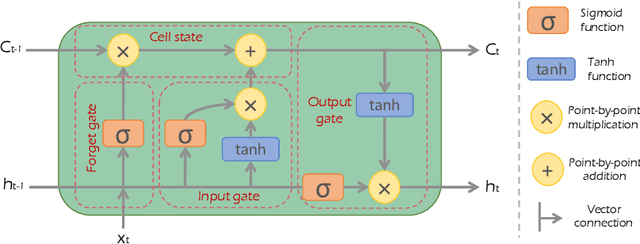



Abstract:Smart energy performance monitoring and optimisation at the supplier and consumer levels is essential to realising smart cities. In order to implement a more sustainable energy management plan, it is crucial to conduct a better energy forecast. The next-generation smart meters can also be used to measure, record, and report energy consumption data, which can be used to train machine learning (ML) models for predicting energy needs. However, sharing fine-grained energy data and performing centralised learning may compromise users' privacy and leave them vulnerable to several attacks. This study addresses this issue by utilising federated learning (FL), an emerging technique that performs ML model training at the user level, where data resides. We introduce FedTrees, a new, lightweight FL framework that benefits from the outstanding features of ensemble learning. Furthermore, we developed a delta-based early stopping algorithm to monitor FL training and stop it when it does not need to continue. The simulation results demonstrate that FedTrees outperforms the most popular federated averaging (FedAvg) framework and the baseline Persistence model for providing accurate energy forecasting patterns while taking only 2% of the computation time and 13% of the communication rounds compared to FedAvg, saving considerable amounts of computation and communication resources.
Intelligent Blockage Prediction and Proactive Handover for Seamless Connectivity in Vision-Aided 5G/6G UDNs
Feb 21, 2022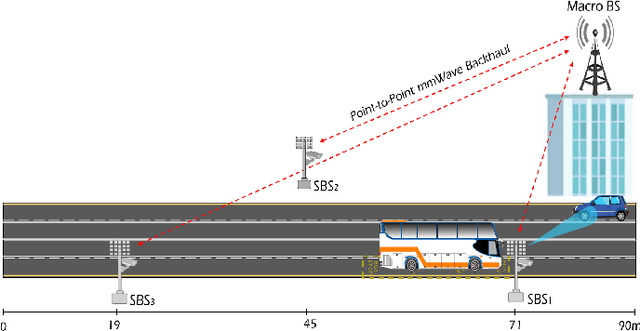



Abstract:The upsurge in wireless devices and real-time service demands force the move to a higher frequency spectrum. Millimetre-wave (mmWave) and terahertz (THz) bands combined with the beamforming technology offer significant performance enhancements for ultra-dense networks (UDNs). Unfortunately, shrinking cell coverage and severe penetration loss experienced at higher spectrum render mobility management a critical issue in UDNs, especially optimizing beam blockages and frequent handover (HO). Mobility management challenges have become prevalent in city centres and urban areas. To address this, we propose a novel mechanism driven by exploiting wireless signals and on-road surveillance systems to intelligently predict possible blockages in advance and perform timely HO. This paper employs computer vision (CV) to determine obstacles and users' location and speed. In addition, this study introduces a new HO event, called block event {BLK}, defined by the presence of a blocking object and a user moving towards the blocked area. Moreover, the multivariate regression technique predicts the remaining time until the user reaches the blocked area, hence determining best HO decision. Compared to typical wireless networks without blockage prediction, simulation results show that our BLK detection and PHO algorithm achieves 40\% improvement in maintaining user connectivity and the required quality of experience (QoE).
Performance of Reconfigurable Intelligent Surfaces in the Presence of Generalized Gaussian Noise
Nov 24, 2021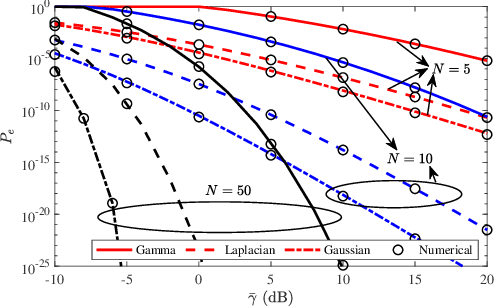
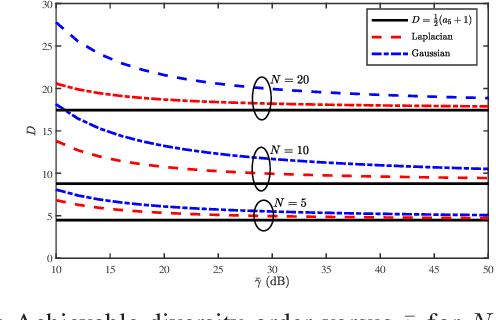
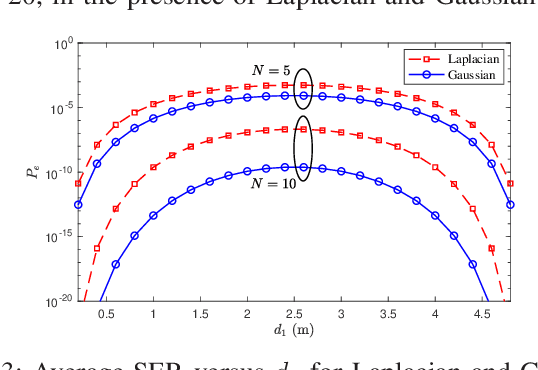

Abstract:In this letter, we investigate the performance of reconfigurable intelligent surface (RIS)-assisted communications, under the assumption of generalized Gaussian noise (GGN), over Rayleigh fading channels. Specifically, we consider an RIS, equipped with $N$ reflecting elements, and derive a novel closed-form expression for the symbol error rate (SER) of arbitrary modulation schemes. The usefulness of the derived new expression is that it can be used to capture the SER performance in the presence of special additive noise distributions such as Gamma, Laplacian, and Gaussian noise. These special cases are also considered and their associated asymptotic SER expressions are derived, and then employed to quantify the achievable diversity order of the system. The theoretical framework is corroborated by numerical results, which reveal that the shaping parameter of the GGN ($\alpha$) has a negligible effect on the diversity order of RIS-assisted systems, particularly for large $\alpha$ values. Accordingly, the maximum achievable diversity order is determined by $N$.
Edge-Native Intelligence for 6G Communications Driven by Federated Learning: A Survey of Trends and Challenges
Nov 14, 2021



Abstract:The unprecedented surge of data volume in wireless networks empowered with artificial intelligence (AI) opens up new horizons for providing ubiquitous data-driven intelligent services. Traditional cloud-centric machine learning (ML)-based services are implemented by collecting datasets and training models centrally. However, this conventional training technique encompasses two challenges: (i) high communication and energy cost due to increased data communication, (ii) threatened data privacy by allowing untrusted parties to utilise this information. Recently, in light of these limitations, a new emerging technique, coined as federated learning (FL), arose to bring ML to the edge of wireless networks. FL can extract the benefits of data silos by training a global model in a distributed manner, orchestrated by the FL server. FL exploits both decentralised datasets and computing resources of participating clients to develop a generalised ML model without compromising data privacy. In this article, we introduce a comprehensive survey of the fundamentals and enabling technologies of FL. Moreover, an extensive study is presented detailing various applications of FL in wireless networks and highlighting their challenges and limitations. The efficacy of FL is further explored with emerging prospective beyond fifth generation (B5G) and sixth generation (6G) communication systems. The purpose of this survey is to provide an overview of the state-of-the-art of FL applications in key wireless technologies that will serve as a foundation to establish a firm understanding of the topic. Lastly, we offer a road forward for future research directions.
Smart and Secure CAV Networks Empowered by AI-Enabled Blockchain: Next Frontier for Intelligent Safe-Driving Assessment
Apr 09, 2021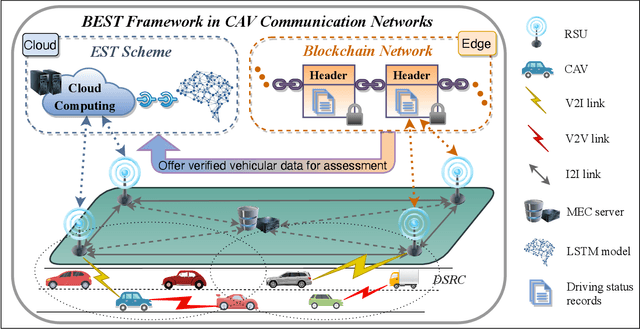
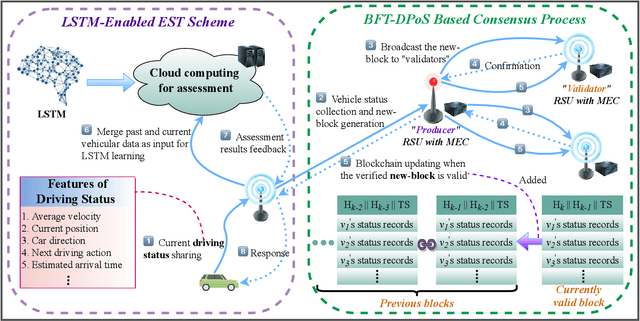
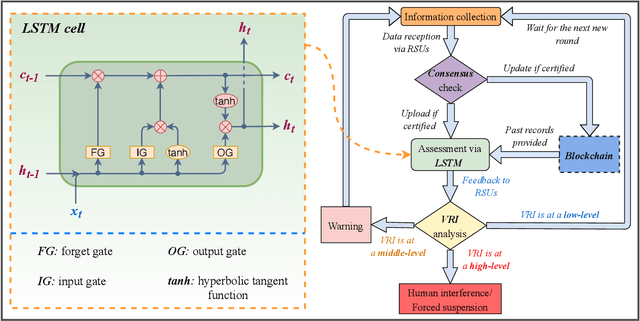
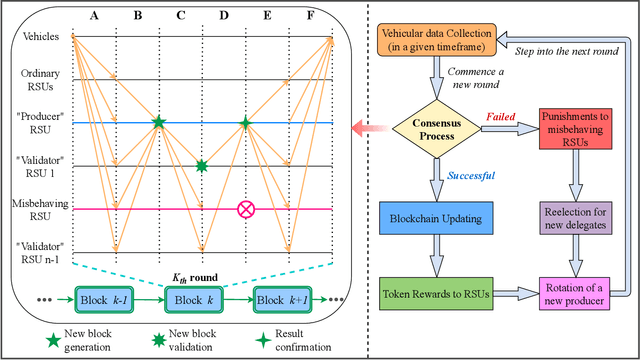
Abstract:Securing a safe-driving circumstance for connected and autonomous vehicles (CAVs) continues to be a widespread concern despite various sophisticated functions delivered by artificial intelligence for in-vehicle devices. Besides, diverse malicious network attacks become ubiquitous along with the worldwide implementation of the Internet of Vehicles, which exposes a range of reliability and privacy threats for managing data in CAV networks. Combined with another fact that CAVs are now limited in handling intensive computation tasks, it thus renders a pressing demand of designing an efficient assessment system to guarantee autonomous driving safety without compromising data security. To this end, we propose in this article a novel framework of Blockchain-enabled intElligent Safe-driving assessmenT (BEST) to offer a smart and reliable approach for conducting safe driving supervision while protecting vehicular information. Specifically, a promising solution of exploiting a long short-term memory algorithm is first introduced in detail for an intElligent Safe-driving assessmenT (EST) scheme. To further facilitate the EST, we demonstrate how a distributed blockchain obtains adequate efficiency, trustworthiness and resilience with an adopted byzantine fault tolerance-based delegated proof-of-stake consensus mechanism. Moreover, several challenges and discussions regarding the future research of this BEST architecture are presented.
 Add to Chrome
Add to Chrome Add to Firefox
Add to Firefox Add to Edge
Add to Edge